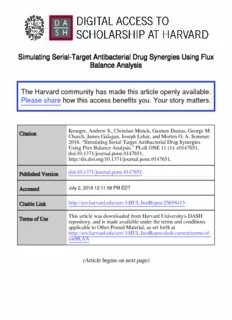
Simulating Serial-Target Antibacterial Drug Synergies Using Flux Balance Analysis PDF
Preview Simulating Serial-Target Antibacterial Drug Synergies Using Flux Balance Analysis
Simulating Serial-Target Antibacterial Drug Synergies Using Flux Balance Analysis Citation Krueger, Andrew S., Christian Munck, Gautam Dantas, George M. Church, James Galagan, Joseph Lehár, and Morten O. A. Sommer. 2016. “Simulating Serial-Target Antibacterial Drug Synergies Using Flux Balance Analysis.” PLoS ONE 11 (1): e0147651. doi:10.1371/ journal.pone.0147651. http://dx.doi.org/10.1371/journal.pone.0147651. Published Version doi:10.1371/journal.pone.0147651 Permanent link http://nrs.harvard.edu/urn-3:HUL.InstRepos:25658413 Terms of Use This article was downloaded from Harvard University’s DASH repository, and is made available under the terms and conditions applicable to Other Posted Material, as set forth at http:// nrs.harvard.edu/urn-3:HUL.InstRepos:dash.current.terms-of-use#LAA Share Your Story The Harvard community has made this article openly available. Please share how this access benefits you. Submit a story . Accessibility RESEARCHARTICLE Simulating Serial-Target Antibacterial Drug Synergies Using Flux Balance Analysis AndrewS.Krueger1☯,ChristianMunck2☯,GautamDantas3,4,5,GeorgeM.Church6, JamesGalagan1,7,JosephLehár1*,MortenO.A.Sommer2* 1 BostonUniversity,44CummingtonSt,Boston,MA,UnitedStatesofAmerica,2 TechnicalUniversityof Denmark,NovoNordiskFoundationCenterforBiosustainability,Hørsholm,Denmark,3 CenterforGenome Science&SystemsBiology,WashingtonUniversitySchoolofMedicine,StLouis,Missouri,UnitedStatesof America,4 DepartmentofPathology&Immunology,WashingtonUniversitySchoolofMedicine,StLouis, Missouri,UnitedStatesofAmerica,5 DepartmentofBiomedicalEngineering,WashingtonUniversity, St.Louis,Missouri,UnitedStatesofAmerica,6 DepartmentofGenetics,HarvardMedicalSchool,Boston, Massachusetts,UnitedStatesofAmerica,7 BroadInstitute,CambridgeCenter,Cambridge,Massachusetts, UnitedStatesofAmerica ☯Theseauthorscontributedequallytothiswork. *[email protected](JL);[email protected](MOAS) Abstract OPENACCESS Fluxbalanceanalysis(FBA)isanincreasinglyusefulapproachformodelingthebehaviorof metabolicsystems.However,standardFBAmodelingofgeneticknockoutscannotpredict Citation:KruegerAS,MunckC,DantasG,Church GM,GalaganJ,LehárJ,etal.(2016)Simulating drugcombinationsynergiesobservedbetweenserialmetabolictargets,eventhoughsuch Serial-TargetAntibacterialDrugSynergiesUsingFlux synergiesgiverisetosomeofthemostwidelyusedantibiotictreatments.Hereweextend BalanceAnalysis.PLoSONE11(1):e0147651. FBAmodelingtosimulateresponsestochemicalinhibitorsatvaryingconcentrations,by doi:10.1371/journal.pone.0147651 divertingenzymaticfluxtoawastereaction.Thisfluxdiversionyieldsverysimilarqualitative Editor:StephenS.Fong,VirginiaCommonwealth predictionstopriormethodsforsingletargetactivity.However,wefindverydifferentpredic- University,UNITEDSTATES tionsforcombinations,wherefluxdiversion,whichmimicsthekineticsofcompetitivemeta- Received:November8,2015 bolicinhibitors,canexplainserialtargetsynergiesbetweenmetabolicenzymeinhibitors Accepted:January6,2016 thatweconfirmedinEscherichiacolicultures.FBAfluxdiversionopensthepossibilityfor Published:January28,2016 moreaccurategenome-scalepredictionsofdrugsynergies,whichcanbeusedtosuggest treatmentsforinfectionsandotherdiseases. Copyright:©2016Kruegeretal.Thisisanopen accessarticledistributedunderthetermsofthe CreativeCommonsAttributionLicense,whichpermits unrestricteduse,distribution,andreproductioninany medium,providedtheoriginalauthorandsourceare Introduction credited. Microbialinfectionsareamajorburdenonsocieties,andtheemergenceofdrug-resistantbac- DataAvailabilityStatement:Allrelevantdataare teriaposesanincreasingthreattohumanwelfare.Drugcombinationscanovercomeresistance withinthepaperanditsSupportingInformationfiles. bycreatingnewtherapeuticavenuesinaccessibletosingletargetdrugs[1–3]oreliminating Funding:MOASacknowledgesfundingfromThe functionalredundanciesexhibitedbyrobustbiologicalnetworks[4].However,althoughcom- LundbeckFoundation(www.lundbeckfonden.com) binationsareincreasinglythestandardofcareformanybacterialinfections[5,6]thecomplex- andEUFP7-HealthProgramEvotar(282004)(www. ityofmicrobialbiologyandthevastnumberofpossibletargetcombinationsmakesfinding cordis.europa.eu/fp7/).Thefundershadnorolein studydesign,datacollectionandanalysis,decisionto neweffectivedrugcombinationschallenging. publish,orpreparationofthemanuscript. Systemsbiologymayprovideasolutiontothischallenge[7–9],bymodelingmicrobialsys- temsascomplexnetworksofinteractingcomponents.Dynamicmodelsofmicrobialfunction CompetingInterests:Theauthorshavedeclared thatnocompetinginterestsexist. underdrugtreatment[10,11]canprovidedetailedandaccuraterepresentationsofphenotypes, PLOSONE|DOI:10.1371/journal.pone.0147651 January28,2016 1/18 SimulatingSerial-TargetAntibacterialDrugSynergiesUsingFBA butthescaleofsuchmodelsislimitedbythescarcityofkineticmolecularreactionratemea- surements.Graph-theoreticnetworksofmetabolicinteractionsfoundinKEGGorMetacyc [4,12,13]canaddressthetruescaleofmicrobialbiology,butarelimitedtostaticrepresenta- tionswithonlylimitedrelevancetodrugresponsephenotypes. Asuccessfulapproachtowardsgenome-scalemodelingisFluxBalanceAnalysis(FBA)[14– 16],whichutilizesreactionstoichiometrytomodelmetaboliccapabilitiesatsteadystate(Fig1A). Byintegratingthepropertiesofmetabolicnetworksintoasinglegrowthphenotype,FBAenables predictionsofenzymaticgeneessentialityandevengeneticinteractions.FBAapproacheshave beenusedtopredictthenutrient-dependentmetabolicphenotypeofgeneknockouts(Fig1B) [15,17],andhavebeensuccessfullyappliedtomodelthecombinedeffectsofdoubleknockoutsin microbialsystems[18].Recently,integrationofproteomestructurehasallowedfortheprediction ofthetemperaturedependenceofmetabolicreactionsonagenomewidescale[19].Severalmeth- odshavealsobeendevelopedtoincorporategeneexpressionandotherhighthroughputdatato constrainfluxesthroughparticularreactionspredictingmetabolicstatescorrespondingtospecific geneexpressionstates;E-fluxinparticularhasbeenusedtopredicttheimpactofdrugsgiven expressiondata[20–24].Finally,incorporationofgeneexpressionnetworksandproteintransla- tionprocesseshasenabledamechanisticallydetaileddescriptionofcellulartrade-offsoccurring duringvariousgrowthphasesandnutrientlimitations[25–29].However,noneoftheabovemeth- odologiesmodelstheeffectsofdrugdosing.Thecontinuousresponsestovaryinginhibitorcon- centrationsareespeciallycriticalforidentifyingandinterpretingdrugcombinationeffects[10]. HerewehaveextendedFBAmodelingtosimulatedrugeffectsovermultipledoses.We explorenewmethodsforsimulatingdrugtreatmentswithFBA,consideringbothdirecttarget fluxrestriction[3]andamodelthatdivertsfluxtonon-productivewastepathways(Fig1).In fluxrestriction“FBA-res”,thefluxthroughthetargetreactionisrestrictedbyavariablescalar factor(Fig1C),whileinflux-diversion“FBA-div”,weinsteaddivertfluxtoawastereservoir (Fig1D).Thetwomethodsyieldsimilarresultstoknockoutsimulationsforsingleagenteffects, buthaveverydifferentpredictionsforcombinations.OnlyFBA-divpredictspotentantibiotic synergiestargetingmetabolism. MaterialsandMethods Simulations TheEscherichiaColiiAF1260modelcreatedbyBernhardPalsson’sgroupatUCSDservesas ourbacterialmodelinthiswork[30],whichcontainsspecies-specificmetabolicreactions, linkedtogetherinanetworkbysubstratesandproducts.Foroursimulations,wewillassume bacterialgrowthonrichmediawithamplesuppliesofoxygen,glucose,ammonia,potassium, sulphur,andallaminoacids. AlldrugeffectsimulationswereperformedwithanR-scriptusingtheRpackageSybil(Sys- temsBiologyLibraryforR)[31]andthegenome-scalereconstructionofEscherichiaColi.The “Ec_iAF1260_flux2”modelwasdownloadedinxmlformatandaddedtotheRworkspace. Afterdownloading,thegrowthfluxiscalculatedusingthebuilt-inoptimizationmodule“opti- mizeProb”withthealgorithmsetto“fba”.ThetheoreticalframeworkforFBA-resmodelsdrug perturbationsasascalarrestrictionoffluxthroughatargetedreaction.WeimplementFBA-res byreducingthefluxboundsbyascalaralphaforeachdoseofeverytarget.Thiscreatesanew drug-perturbedmodel.Thedrug-perturbedmodelissenttooptimizeProbwiththealgorithm setto“fba”.Growthinhibitioniscalculatedwiththeunperturbedandperturbedgrowthfluxes. Aftereachdoseforcombinationsorsingleagents,weresettotheoriginalmodeltoimplement thenextperturbation.ThetheoreticalframeworkforFBA-divmodelsdrugperturbationsasa scalardiversionofflux,whichdependsonthemagnitudeoftheperturbation(dose).We PLOSONE|DOI:10.1371/journal.pone.0147651 January28,2016 2/18 SimulatingSerial-TargetAntibacterialDrugSynergiesUsingFBA Fig1.SimulationsofinhibitedFBAmetabolism.(A)Cartoonofatargetenzyme“j”whichactsonsubstrate“i”atasteady-statefluxv.Otherenzymesmay j competeforthesamesubstrate,anddownstreamreactionswillconvertallproductsto“biomass”fluxorunproductive“waste”thatisdegradedorexported. PLOSONE|DOI:10.1371/journal.pone.0147651 January28,2016 3/18 SimulatingSerial-TargetAntibacterialDrugSynergiesUsingFBA (B)Whenthetargetisknockedoutbysettingv =0,substratebacklogincreasesflowthroughotherreactions,andincreasedwasteratesreducebiomass.(C) j FBA-resreducesthetargetfluxbyascalarfactorα,causingapartialknockouteffect.(D)ForFBA-div,thereaction'sefficiencyisreducedbyscalingits stoichiometriccoefficients,divertingthebacklogtowaste.Becausethisdiversionpreventsyetmorefluxfromgoingtobiomass,FBA-divyieldsstronger ij inhibitionlevelsthancorrespondingFBA-ressimulations.Inthisillustration,bothFBA-resandFBA-divreducethetargetfluxbythesamefactoralpha,butthe smallerbackloginFBA-divleadstolessnon-wastenetworkfluxbeingdirectedtobiomass,leadingtoastrongertotalinhibition. doi:10.1371/journal.pone.0147651.g001 implementFBA-divbyfirstaddingwastereactionsandwastemetabolitestothemodel.Ini- tiallythewastemetabolitesdonotbelongtoanyreaction,andthewastereactionsconsume wastemetabolitesirreversibly.Tosimulatedrugeffects,theamountofmetabolitesproduced byatargetedreactionarereducedbyalphaandtheremainderofmassisconvertedintoa wastemetabolite,whichisnowconnectedtothetargetedreaction.Wastereactionsconsume anydivertedwastemetabolites.Inthecaseofreversiblereactions,twoirreversiblereactionsare createdwithdifferentwastemetabolites,andthereductionbyalphaisappliedtobothreac- tions.Thisisthedrug-perturbedmodel.Thedrug-perturbedmodelissenttotheoptimization module“optimizeProb”withthealgorithmsetto“fba”.Growthinhibitioniscalculatedwith theunperturbedandperturbedgrowthfluxes.Aftereachdoseforcombinationsorsingle agents,weresettotheoriginalmodeltoimplementthenextperturbation. Drugeffectsonatargetedmetabolicreactionwereimplementedinthegenome-scalemodel eitherbylimitingthetargetflux(FBA-res)orlimitingtheamountofmassconvertedfromsub- stratetoproductbydivertingmetabolicmasstoawastereaction(FBA-div).Inhibitionvalues Inhib=1-f /f ,wheref andf arethesimulatedbiomassfluxratesforuntreatedand treat wt wt treat drugtreatedbacteria.InbothofourmodelimplementationstheMOMAquadraticprogram- mingalgorithmforsimulatingperturbedbiologicalnetworkswasimplementedtofindthe changeinbiomassflux.TheIC50valueforareactiondescribestheamountbywhichreaction fluxmustbereducedtoinhibitgrowthby50%.ForFBA-res,fluxisdirectlyrestrictedbyasca- lardrugconcentration,andsotheIC50isthescalarthatachievesa50%growthinhibitingflux restriction.ForFBA-div,fluxisdivertedtoawastereaction,andsotheIC50isthevaluethat achieves50%growthinhibitingfluxdiversion.First,acentralperturbationofα (where cent α =1+[Inhibitor]/K andforsimplicityK =1)wasfoundforeachtargetenzymeusinga cent i i bisectionsearchtoyieldhalftheinhibitionlevelofafullFBAgenedeletion(forenzymesshow- ingnodeletionphenotype,weusedα=5,000,000sincethisvaluereproducedsyntheticlethal interactionsin[12].Simulatedresponsecurveswerethengeneratedforeachenzyme,withfive concentrationscenteredonthisα using3xdilutionstepsofinhibitorconcentration(α-1), cent coveringa~100xdynamicrange(Fig2A).Foreachpairofagents,wethengenerateddose matricesbysimulatingcombinedinhibitorsatallpairsofthoseconcentrations(Fig2B).Gradi- entorsecant-basedoptimizationcouldprovidefastersolutions,soreadersmaywishtoexplore suchmethodsinfutureapplicationsofthisapproach.Completeanalysismethodsareprovided asS1Dataset,whichincludesthemetabolicnetworkmatrix,theanalysiscode,andallsupport- ingdatafiles.CompletesimulationresultsarealsoprovidedinS1Table. Singleagenteffect,combinationsynergyscore,andepistasis Weusedsimplemetricsofsingleagentandcombinedinhibitorresponses(Fig2A),basedon maximuminhibitionlevelsmax(I)oron50%inhibitoryconcentrationsIC50.Comparingmax(I) valuespermitscomparisonswithstandardFBAknockouts,whileIC50sallowfulleruseofthe dose-responsivenessofinhibitors.Themaximuminhibitionmax(I)and50%crossingconcentra- tionIC50wasmeasuredforeachtarget,andifmax(I)<0.5,IC50wassettothetopconcentration. Synergywasthendeterminedforeachdosematrixusingeitheraneffectdifferencemax(ΔI) or“shiftindex”SI50,comparedtothesingleagents(Fig2B).ThecombinationdataI (blue XY PLOSONE|DOI:10.1371/journal.pone.0147651 January28,2016 4/18 SimulatingSerial-TargetAntibacterialDrugSynergiesUsingFBA PLOSONE|DOI:10.1371/journal.pone.0147651 January28,2016 5/18 SimulatingSerial-TargetAntibacterialDrugSynergiesUsingFBA Fig2.Activityandsynergymeasuresforeachcombination.(A)Inhibitionofeachenzymewassimulatedatfiveαconcentrations,using3-folddilution intervalscenteredontheconcentrationthatyieldedhalfofthemaximumsimulatedeffect.Notethatthe3xdilutionstepswereconstantinsimulated concentrationα-1,sotheyarenotalwaysequalonthesecurveplotsbasedonα.Themaximuminhibitionmax(I)and50%crossingconcentrationIC50was measuredforeachtarget(IC50=topconcentrationifmax(I)<0.5),andeachcombinationwassimulatedatall25concentrationpairs.(B)Forcombinations, wescoredthemaximumeffectmax(I)andsynergyoverGaddum’s“bestsingleagent”referencemax(ΔI)=max{I -max(I ,I )}acrossallinhibitionsI .We XY X Y XY alsocalculated“potencyshiftindex”fromthe50%inhibitioncrossingconcentrations(C50 ,C50 )alongthematrixdiagonal(blue),whereSI50=max(C50 / X Y X IC50 ,C50 /IC50 ).Epistasistypesfor(C)FBA-resand(D)FBA-divsimulationsonthreeexampletargetpairs.Interactionswereclassifiedbasedonthe X Y Y singleagentandcombinationeffectandsynergy,aseithernon-interacting“None”,syntheticlethality“SL”betweeninactiveinhibitors,partialSL“PSL” involvingoneactiveagent,orpotentiation“Pot”betweentwoactiveinhibitors. doi:10.1371/journal.pone.0147651.g002 point)arecomparedtothecorrespondingsingleagentresponsevaluesI ,I (greenpoints), X Y andmax(ΔI)=max{I -max(I ,I )},showstheGaddum“bestsingleagent”expectation[32]. XY X Y Allcombinationpointswereconsidered,withthelargestdifferenceacrossthematrixrecorded asthescore.Positivemax(ΔI)valuescorrespondtosynergy(moreeffectthanthebettersingle agentatcomparabledoses).Fordoseshifting,thematrixdiagonal(bluearea)iscomparedto thetwosingleagentcurves(greenareas).Thecombination’s50%inhibitorycrossingpoint alongthediagonalhassingleagentcomponentconcentrationsC50 andC50 ,whicharecom- X Y paredtothesingleagent50%inhibitoryconcentrationsIC50 andIC50 ,tocalculate X Y SI50=max(C50 /IC50 ,C50 /IC50 ).ThisSI50indicateswhetherthecombinationshows X X Y Y synergistic(SI50<1)orantagonistic(SI50>1)doseshifting,relativetotheGaddumresponse surface.WealsocalculatedastandardLoewecombinationindexCI50=C /IC50 +C / X X Y IC50 ,whichmeasuressynergyrelativetoLoewedoseadditivity[33],whichisusedtodeter- Y minewhetheracombinationoutperformsa“drug-with-itself”shamcombination(CI50=1for dose-additive).AllscoresforsimulatedandexperimentalcombinationsarelistedinS1Table. Simulatedepistasiswasclassified(Fig2Cand2D)basedonthemax(I)valuesforacombi- nationanditssingleagents.Ifacombination’smax(I)<0.05ormax(ΔI)<0.05,wesetepista- sistonon-interaction“None”,correspondingtoaGaddum“bestsingleagent”interaction model.Epistasiswasthensettopotentiation“Pot”ifsingleagentmax(I)>=0.5forboth agents,syntheticlethal“SL”ifmax(I)<0.5forbothagents,orpartialsyntheticlethal“PSL” otherwise.Toaccountforhighernoiselevelsinexperimentalcombinations,weusedthesame classificationscheme,exceptthatepistasis=Nonewascalledwhenmax(I)<0.25ormax(ΔI) <0.25foracombination.EpistasiscallsarerecordedinS1Table. Proliferationassay Toexperimentallyvalidatethepredicteddruginteractions,28drug-pairsweretestedagainstE. coliMG1655(S3Table).Inordertoexplorethefullinteractionsurfacethedrugpairswere testedinan8x8well2ddrug-gradientmatrixina96wellplate,inadditiontothedrugmatrix theplatealsocontainedgradientsforeachofthesingledrugsaswellasnegativeandpositive controls.Forboththedrugmatrixandthesingledruggradientsthehighestdrugconcentra- tionswere4timesabovetheminimalinhibitoryconcentration(MIC).Theplateswereinocu- latedwitha96pinreplicatorandincubated18–20hoursat37°C.Afterincubation,OD600was readusingaBioTekH1platereader.Eachplatewasproducedinfivereplicates.Rawdataare presentedinS4Table,andresponsescoresareinS1Table. Results Fluxbalanceanalysisframeworksformodelingdruginhibition Extensivenetworksofmicrobialmetabolismhavebeenconstructedthatlinktogetherthou- sandsofspecies-specificmetabolicreactionsminedfromtheliteratureandonlinedatabases [34].Simulatingthebehaviorofmicrobialmetabolismrequiresnotonlythestoichiometry PLOSONE|DOI:10.1371/journal.pone.0147651 January28,2016 6/18 SimulatingSerial-TargetAntibacterialDrugSynergiesUsingFBA capturedbysuchnetworks,butalsodetailedkineticparameterswhichareunknownformost reactions–evenforwell-studiedmicrobeslikeE.coli.FBAaddressesthislimitationbyreplacing thoseparameterswithlinearfluxesthroughallthemetabolicreactions,andusinglinearpro- grammingtoderivesteady-statefluxvaluesoptimizedbasedonanobjectivefunctioncon- structedfromexperimentalabundancesofnucleotides,aminoacidsandofanabolic metabolites[15,16,35].FBAmodelsoptimizesteady-stateproductionoftheseessentialbuild- ingblocks,enforcingconsistencywithlimitsimposedbythenetwork’sconnectivity,fluxlimits andtheconservationofmassbetweenreactions. FBAmodelshavebeenusedtosuccessfullypredicttheeffectsofgeneticknockouts[15,17].In FBA,understeadystate,asystemofj=1...Nreactionsbetweeni=1...Mmetabolitesshould satisfy∑ s v =0,wherev arethereactionvelocitiesands arestoichiometriccoefficientsthat j ij j j ij accountforreactionaffinitiesandconnectivity.FBAmodelssolveforthev thatmaximizesimu- j latedfluxthroughtheobjectivefunction,constrainedbythismassconservationrequirementand anyv <v <v limits.Tomodelgeneessentialityusingthestandardknockout“FBA-ko” j,min j j,max approach,thetargetenzyme’sreactionrateissettov =0,afterwhichthemodelisre-optimized j withalinearprogrammingalgorithmtomaximizetheobjectivefunction(Fig1BandS1Fig). Growthisrepresentedbyabiomassreactionwhichintegratestheoutputsfrommanymetabolic pathways.ArefinementtoFBAapplies“minimizationofmetabolicadjustment”(MOMA)[36], whichrequiresthere-optimizedreactioncoefficientstominimizetheirdistancefromtheunper- turbedvalues,ratherthanseekingthemaximumobjectivefunctionfluxconsistentwiththe appliedconstraints.MOMAhasbeenappliedtoE.coliandyeastmetabolicnetworksandcan successfullypredictphenotypicresponsestosingle[36]anddoubleknockoutexperiments[18]. ExtendingFBAtodrugperturbations,weconsidertwoapproaches:our“FBA-res”(previously describedinLeharet.al.2009[3])directlyrestrictsthetargetfluxwhileour“FBA-div”diverts fluxtonon-productivewaste.FBA-resreducesthefluxv throughatargetedreactionbyascalar j factorα(Fig1CandS1Fig).Thus,insteadofFBA’sv =0constraint,wesetv!v/αandre-opti- j j j mizethereactionfluxes,usingMOMA.FBA-divmodelingscalesdownthetarget’sstoichiometric coefficient,ratherthanitsmaximumreactionrate(Fig1DandS1Fig).Specifically,FBA-div inhibitsanenzymebysettings !s /α,formetabolitestargetedbytheinhibitor,beforere-opti- ij ij mizingtotheobjectivefunction.Toconservemass,weintroducetransportreaction,s ,with i(N+1) compensatingstoichiometriccoefficientss =1-∑ s /αthatdivertexcesssubstratetoaninfi- i(N+1) j ij nitewastesink.WeusestandardFBAlinearprogrammingtosolvetheoptimizationproblemin conjunctionwithourFBA-divmethodology.IncontrasttoFBA-res,thiswastediversionprevents otherenzymesfromincreasingtheirreactionratesinresponsetotargetfluxrestriction.Thisusu- allypredictsgreaterbiomassreductionsthanFBA-resforthesameleveloftargetfluxinhibition. Simulatingdrugepistaticinteractions Toevaluatetheseapproaches,wesimulatedcombinationeffectsusingstandardFBA-ko,FBA- resandFBA-div,appliedtotheiAF1260modelofEscherichiacolimetabolism[30].Toexplore mechanisticpatterns,wechose50enzymestocoversyntheticlethalsynergiesandantagonisms foundusingFBA-ko[12]andsamplekeypathwaysinbacterialmetabolism(S2Table).Inhibi- tionofeachtargetwassimulatedat5“drug”concentrationsusingFBA-resandFBA-div,in eachcaseestimatinginhibitionbythefluxthroughthegrowthreactioninperturbedand unperturbedstates(MaterialsandmethodsandS1Fig).Weusedthesamemethodologyto generatecombinationresponsematricesacrossall25pairingsofsingledrugconcentrations. Toscorethesimulationresults,weusedmetricsofsingleagentandcombinedinhibitor responses,basedonmaximuminhibitionlevelsoron50%inhibitoryconcentrationsIC50(Fig 2Aand2B),andfocusedouranalysisonthemaximumeffectmax(I)andsynergyscoremax PLOSONE|DOI:10.1371/journal.pone.0147651 January28,2016 7/18 SimulatingSerial-TargetAntibacterialDrugSynergiesUsingFBA (ΔI).Wealsoclassifiedsimulatedinteractionsintofourepistasistypes,basedonthedose matrixresponseshapes(Fig2Cand2D).Theseanalyseswereperformedforall1225possible pairwisecombinationsofour50targets(S1Table). Thesingleagentresponseswereverysimilarbetweenmethodologies,butcombinationsdif- feredgreatly(Fig3andS2–S4Figs).BothFBA-resandFBA-divsingleagentactivitieswere consistentwithFBAknockouts(R~1,Fig4).Moreover,eventheIC50concentrationsshowed astrongquantitativecorrelation(R=0.98,Fig5).Forcombinations(Fig4B),allthree approachesmostlygeneratednon-interactingpairs,withmax(I)reflectingthemoreeffective singleagents,andnoepistasis.However,thereisaclearincreaseinthenumberandvarietyof interactionsbetweenFBA-ko,FBA-res,andFBA-div.WhileFBA-kosynergieswererestricted tosyntheticlethal(SL)epistasis,somepartialsyntheticlethal(PSL)appearedinFBA-res,anda largenumberofpotentiation(Pot)synergieswereaddedwithFBA-div. Arrangingtheresultsbytargetpathwayrevealsinformativepatterns(Fig3andS2–S4Figs). First,welocatedouriAF1260targetsontheiJR904[37]pathwaymaps,andthenassignedgene identitieswithreferencetoKEGG[34].NovisualmapswerepublishedfortheiAFmodelthat weused,soweusedtheiJRmapstoconstructourvisualdisplays.Pathwayswerethenrepre- sentedusingconcisedescriptorslistedinS2Table.Allthreesimulationapproachesshowactive singleagentsclusteredinpathwaysessentialforE.coligrowthinrichmedia(glycolysis,citrate cycle,folateandmureinbiosynthesis,andcertainaminoacidpathways),andtheresponsesfor anyparticularenzymearemoreorlessuniformwithineachsuchpathway. Fig3.ComparingFBA-koandFBA-divinteractionsacrossmetabolicpathways.Simulatedinteractionsfor(A)FBA-koand(B)forFBA-div,inselected metabolicpathways.Morecompletesimulationresultsareshownelsewhere(S2–S4Figs).Eachsymbolrepresentsthesimulatedresponsetoinhibitinga singleorpairoftargets(seeFig2),withenzymesorganizedbypathwayandmetabolicreactionorderintheiAF1260model.Symbolshapeshowsthetypeof epistasis(syntheticlethal“SL”,partialsyntheticlethal“PSL”,potentiation“Pot”,ornon-interaction“None”),sizeshowstheeffectmax(I),andcolorshowsthe synergymax(ΔI)betweentwotargets(samescaleasFig2).Singleagentsareshownalongthebottomandrightedges.ThetrianglesforPSLepistasispoint towardtheinactiveagentinthepairing.SingleenzymeeffectsareverysimilarbetweenFBA-koandFBA-div,butinteractionsareverydifferent.Mostnotably, strongPotsynergiesareobservedbetweenserialtargetsinthesamepathwayunderFBA-div(A),whicharenotpredictedbyFBA-ko(B)orFBA-res(S4Fig). doi:10.1371/journal.pone.0147651.g003 PLOSONE|DOI:10.1371/journal.pone.0147651 January28,2016 8/18 SimulatingSerial-TargetAntibacterialDrugSynergiesUsingFBA Fig4.Comparingsingleagentandcombinationeffectsbetweenmethods.(A)Simulatedsingleagentinhibitionsareveryconsistentbetween methodologies.Acrossthe50simulatedinhibitors,bothFBA-resandFBA-divmethodologiesyieldedverysimilarmax(I)scorestothoseobtainedfrom standardFBA-ko.Datawererandomlyditheredby~0.03inbothdirectionstovisuallyseparateoverlappingpoints.(B)Simulatedcombinationeffects, however,showmanydeviationsinmax(ΔI)fromFBA-ko,andsubstantialdifferencesinepistasistypes.Acrossall1225simulatedpairs,FBA-koyielded mostlyNone,withafewSL(2%).SimulatingwithFBA-resconvertedafewoftheNonetoPSL(5%),andFBA-divreproducedalltheFBA-ressynergiesand convertedanother16%fromNonetoPot.Datawererandomlyditheredby~0.03toseparateoverlappingpoints. doi:10.1371/journal.pone.0147651.g004 PLOSONE|DOI:10.1371/journal.pone.0147651 January28,2016 9/18
Description: